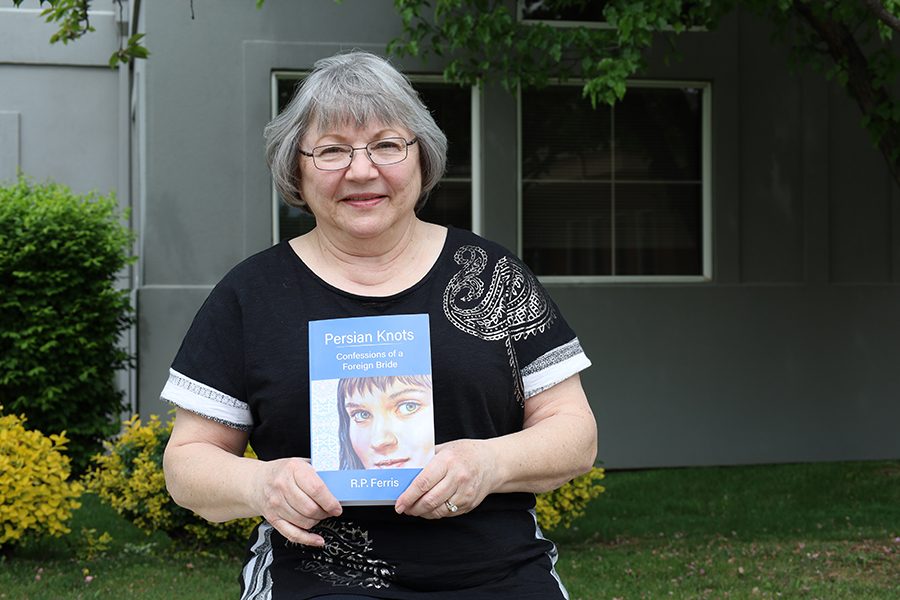
Home » 71-year-old writes memoir about being a foreign bride
71-year-old writes memoir about being a foreign bride

Local author R. P. Ferris recently published a memoir on her time spent in Iran in the 1970s called, “Persian Knots: Confessions of a Foreign Bride.”
Photo by Rachel VisickMay 2, 2024
In the 1970s, a Kennewick woman spent four years living in Iran with her then-husband and his family during a time of civil unrest. Now, she’s published her first book about those experiences.
R. P. Ferris, 71, spent the last 13 years working on her memoir, “Persian Knots: Confessions of a Foreign Bride.”
Her background is in engineering, including work with General Motors. When her current husband suggested she write a book about her experiences, she initially dismissed it. Although Ferris was experienced in technical writing, approaching a book was something entirely different.
“But I also recognized I couldn’t let go a lot of the events that happened to me,” she said.
So, in 2010, she spoke with a friend who was a published author and started writing.
Writing resources
Originally from the Bay Area of California, Ferris moved to the Tri-Cities in 2005, when her husband’s temporary position at Hanford became long term.
The local community proved valuable in nurturing her writing.
With two bachelor’s degrees and a master’s, all in different fields, Ferris wasn’t looking to further her education to hone her writing skills. Instead, she started out on her own by reading books and attending workshops.
When the Tri-Cities hosted a literature fest in 2016, Ferris befriended an author who was doing a signing there. She was self-taught, and Ferris decided that she could go through the same process.
That friend also pointed her to the Pacific Northwest Writers Association, or PNWA. One of that group’s resources is an annual writing contest, where works entered receive feedback from two judges.
Ferris submitted her work to the contest multiple times and was a finalist in 2022 and 2023. Locally, she has been with the Word Herders group for about nine years.
“Writers as a community are terrific,” Ferris said. “They help one another. We don’t view it as competition.”
Challenges
Writing a memoir came with its fair share of struggles.
Ferris found out that in some ways, she had to treat her work like a novel.
“When you go to a literary agent, they say, ‘You have to have character development. You have to have a plot. You have to have a character arc,’” she said.
Creating dialogue, expressing emotion and working through narrative gaps were all difficulties Ferris encountered. She learned that with dialogue, she could use “conversational intent and personal knowledge” to reconstruct conversations.
Unlike with a fictional story, “you can’t invent something to satisfy one of the parts of the elements of story writing,” Ferris said. The story has to remain truthful.
Some of the experiences were hard to write about. During Ferris’ time in Iran, she had to adjust to a new country, a new language and a difficult life with her in-laws. Just when her personal life began to go more smoothly, civil unrest grew into the Iranian Revolution.
Ferris felt the need to be open about her story. “If you don’t tell (readers) really what happened, they know. People can tell,” she said.
She eventually hired a developmental editor, who was able to teach Ferris instead of merely telling her what to fix.
In the process, Ferris learned about contemporary memoir writing. That meant that the book didn’t have to be written in exact chronological order – she could take advantage of flashbacks to bring in the backstory or other information outside of the immediate timeframe.
“Each time that I thought I had learned what I needed to learn … I wasn’t even close,” Ferris said of her writing process. “So I’d get discouraged.”
But she kept working and looking for what to learn next.
Getting published
Ferris sent queries to literary agents as she began working to get her memoir out in the world.
“What came back loud and clear was that the only memoirs they were interested in were celebrity memoirs that come with a large platform or following,” she said.
Ferris’ fellow local authors encouraged her to pursue self-publishing as an alternative to traditional publishing. “They gave me the confidence to try and do it myself,” she said, so she did.
She had her manuscript copyedited and formatted, and her best friend from childhood, now a portrait artist, worked with her to create the portrait featured on the cover. They added an image of tilework from Iran and Ferris herself designed the layout of the cover.
Both the paperback book and Kindle edition include a table of contents, maps, a character list complete with pronunciations, a foreword by a professor of anthropology and author’s notes.
“This has been in the works for a long time,” Ferris said.
The book was published this March and is available on Amazon at $17 for paperback or $9.99 for Kindle. Ferris’ website is at rpferris.com.
Senior Times
KEYWORDS May 2024




